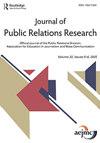The growing importance of faith in public relations
IF 4.4
2区 文学
Q1 COMMUNICATION
引用次数: 2
Abstract
Religion and faith have played influential roles in numerous major events throughout history – from wars and inquisitions to the establishment of education and healthcare systems. In modern times, the influence of religion continues to be evident in many countries throughout the world in a variety of ways. In some countries, religion plays a significant role in the government, while in others it influences society and popular culture. Internationally, some religious figures like the pope and the dalai lama garner significant media attention and are influencers to millions of people – both religious and secular. With 6.1 billion people worldwide professing adherence to a faith (Hackett & McClendon, 2017), communicators and organizations must understand how to connect with stakeholders about issues of religion and develop relationships with these audiences. While Christianity and Islam are the largest religions with 2.3 billion and 1.8 billion followers, respectively (Hackett & McClendon, 2017), understanding other faiths is equally important, since their influence and the level of importance they have in people’s lives varies across countries and regions. For example, the Pew Research Center found that a significant majority of people in Asia, Africa, and South America indicate religion is very important to them (Tamir et al., 2020). Failing to understand different faiths and their roles in people’s lives can present a significant barrier to fostering organization-public relationships. Despite these data points, the intersection of faith, religion, spirituality, and public relations is an under-researched area of scholarship when compared to research on public relations in corporate contexts. Understanding religious stakeholders, their motivations, and their needs has implications that are important for corporate, nonprofit and religion communicators alike. While earlier public relations scholarship (see, Tilson & Chao, 2002; Tilson & Venkateswaran, 2006) began to explore the importance and composition of relationships with religious audiences, current scholars are continuing to build upon research in this area, and this is evidenced by the articles included in this special issue of the Journal of Public Relations Research on faith, spirituality, and public relations: In “Examining devotional campaigns and stakeholder-centric relationships in public relations materials: A case study,” Jordan Morehouse examines one religious institution’s approach to developing and fostering relationships with stakeholders. While this study focuses on one organization, it also indicates how these findings can apply to other religious institutions and thus expand relationship management literature. In particular, this article concludes that organization-public relationships are not the sole focus of many organizations’ relationship-building efforts. This is an important reinforcement of how public relations functions in a religious context. “Social media conversion: Lessons from faith-based social media influencers for public relations,” by Brian Smith, Danielle Hallows, Maggie Vail, Alycia Burnett, and Caleb Porter, seeks to understand the motivations and perspectives of influencers. Specifically, the article focuses on religious and faithbased influencers and furthers the study of influencer relations. While this study does have some clear practical implications for engaging social media influencers, especially faith-based ones, by exploring these in the context of parasocial relationships, it also enhances the understanding of relationship management theories.信仰在公共关系中日益重要
宗教和信仰在历史上的许多重大事件中发挥了重要作用——从战争、宗教调查到教育和医疗体系的建立。在现代,宗教的影响在世界许多国家以各种方式继续显现。在一些国家,宗教在政府中发挥着重要作用,而在另一些国家,它影响着社会和流行文化。在国际上,一些宗教人物,如教皇和达赖喇嘛,引起了媒体的极大关注,并对数百万宗教和世俗人士产生了影响。全世界有61亿人声称信奉一种信仰(Hackett&McClendon,2017),传播者和组织必须了解如何在宗教问题上与利益相关者建立联系,并与这些受众发展关系。虽然基督教和伊斯兰教是最大的宗教,分别拥有23亿和18亿信徒(Hackett&McClendon,2017),但了解其他信仰同样重要,因为它们的影响力和在人们生活中的重要性因国家和地区而异。例如,皮尤研究中心发现,亚洲、非洲和南美洲的绝大多数人表示宗教对他们来说非常重要(Tamir等人,2020)。不了解不同的信仰及其在人们生活中的作用,可能会对培养组织公共关系构成重大障碍。尽管有这些数据点,但与企业背景下的公共关系研究相比,信仰、宗教、精神和公共关系的交叉是一个研究不足的学术领域。了解宗教利益相关者、他们的动机和需求对企业、非营利组织和宗教传播者都很重要。虽然早期的公共关系学术(见,Tilson&Chao,2002;Tilson&Venkateswaran,2006)开始探索与宗教受众关系的重要性和构成,但目前的学者正在继续加强这一领域的研究,这一点可以从本期《公共关系研究杂志》,公共关系:在“研究公共关系材料中的虔诚运动和以利益相关者为中心的关系:案例研究”中,Jordan Morehouse研究了一个宗教机构发展和培养与利益相关者关系的方法。虽然这项研究关注的是一个组织,但它也表明了这些发现如何适用于其他宗教机构,从而扩展关系管理文献。特别是,本文得出的结论是,组织公共关系并不是许多组织建立关系工作的唯一重点。这是对公共关系在宗教背景下如何运作的重要强化。Brian Smith、Danielle Hallows、Maggie Vail、Alycia Burnett和Caleb Porter的《社交媒体转化:从基于信仰的社交媒体影响者那里获得公共关系的教训》试图了解影响者的动机和观点。具体而言,本文关注宗教和信仰影响者,并进一步研究影响者关系。虽然这项研究通过在准社会关系的背景下探索社交媒体影响者,特别是基于信仰的影响者,对吸引他们确实有一些明确的实际意义,但它也增强了对关系管理理论的理解。
本文章由计算机程序翻译,如有差异,请以英文原文为准。
求助全文
约1分钟内获得全文
求助全文

 求助内容:
求助内容: 应助结果提醒方式:
应助结果提醒方式:


